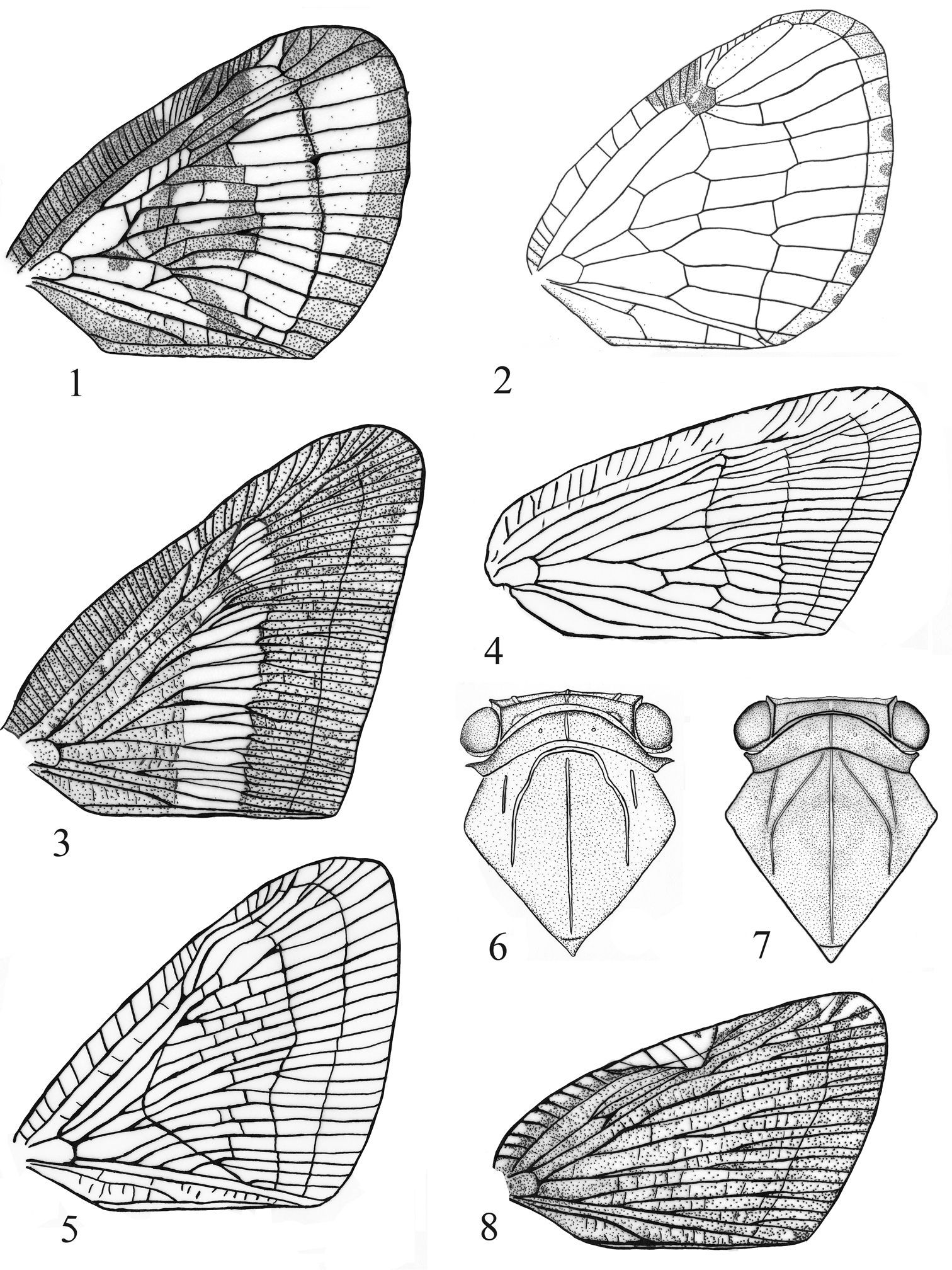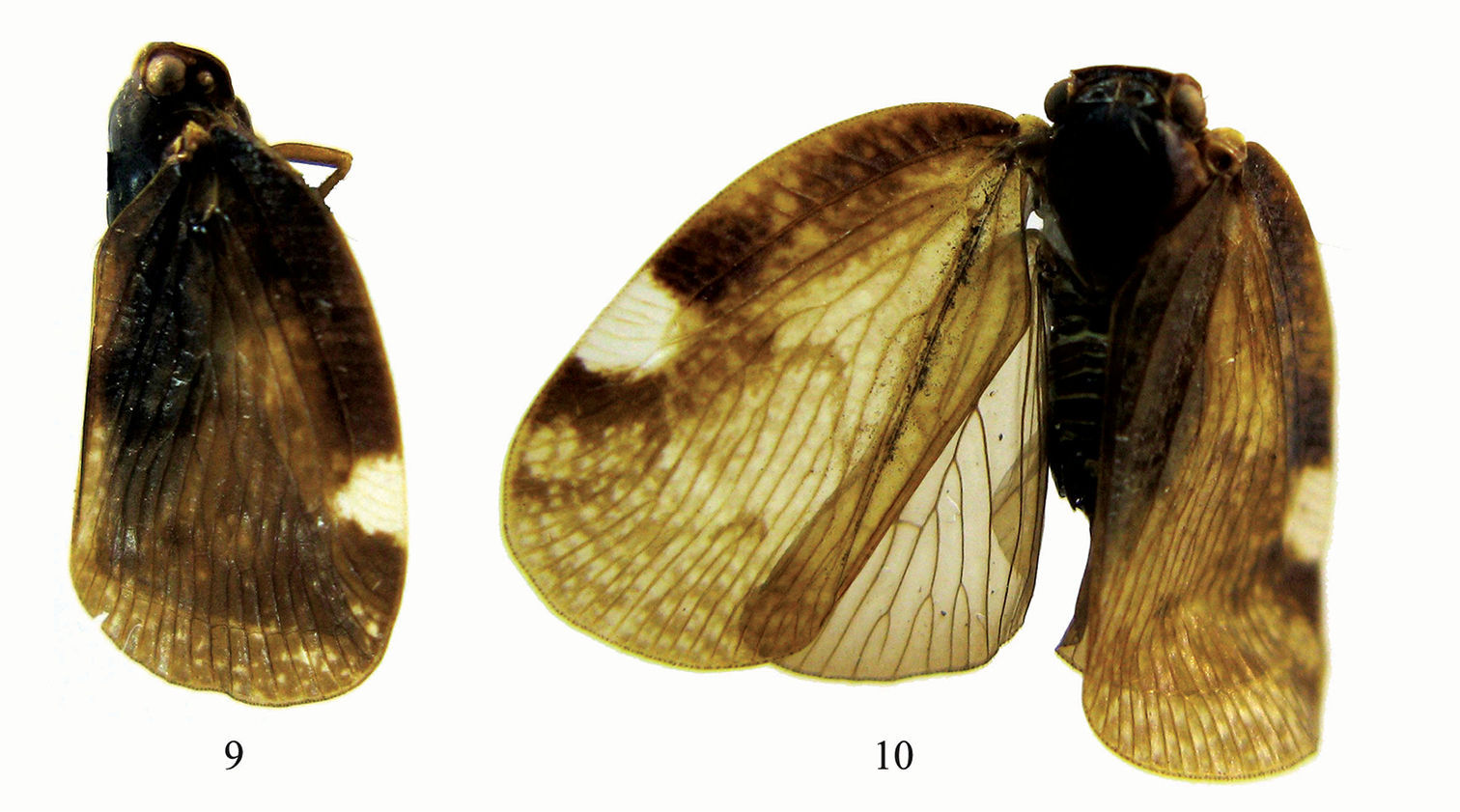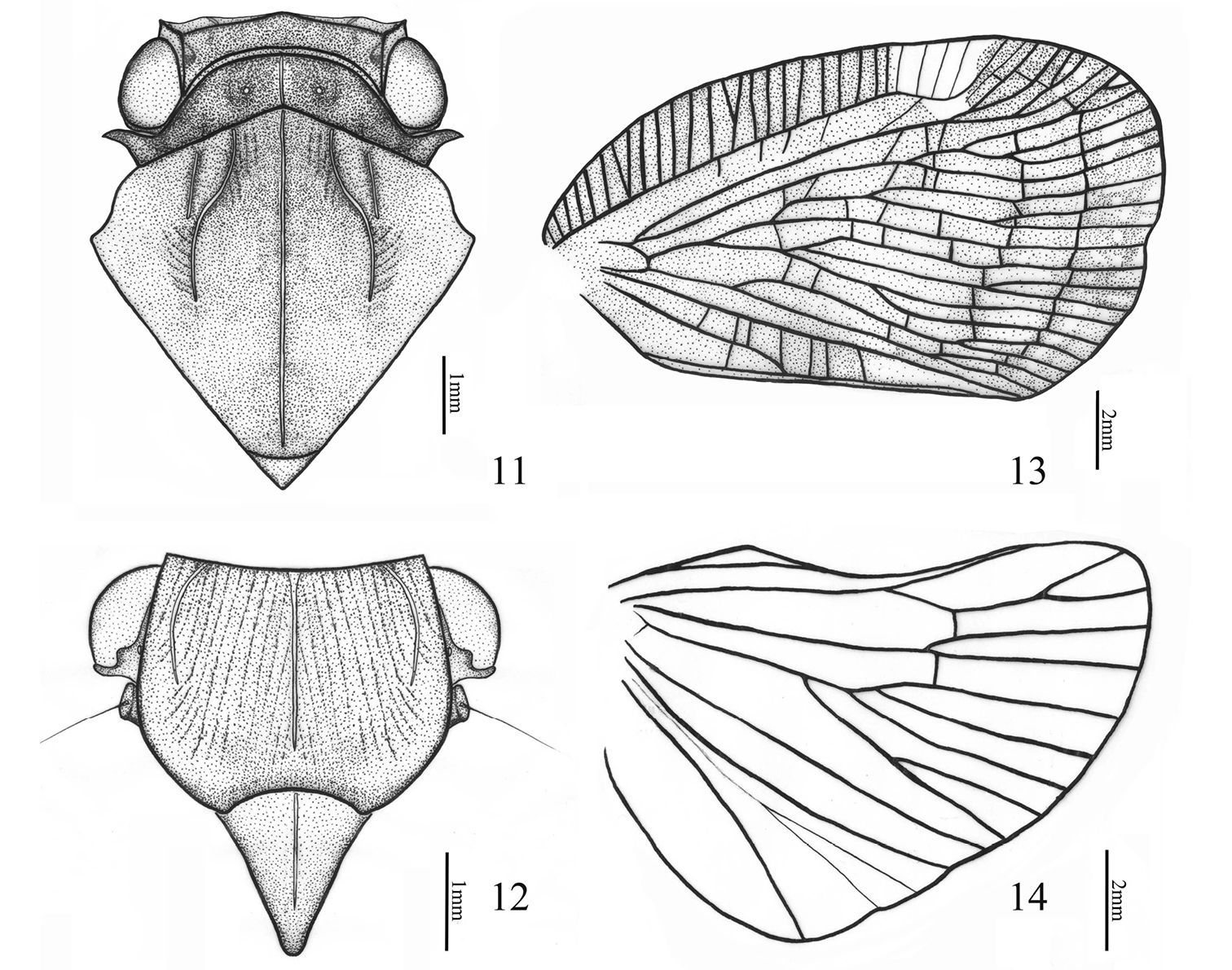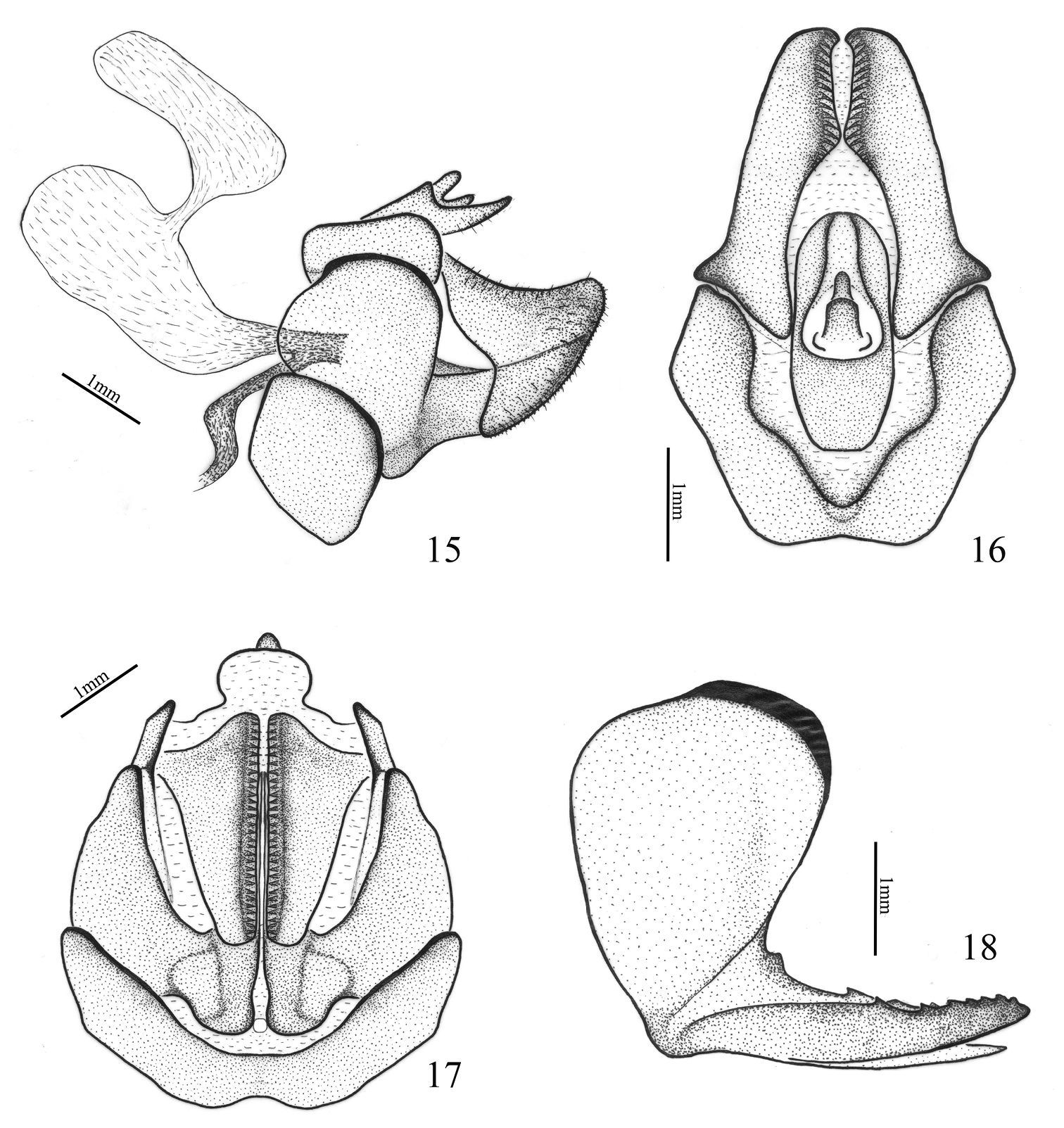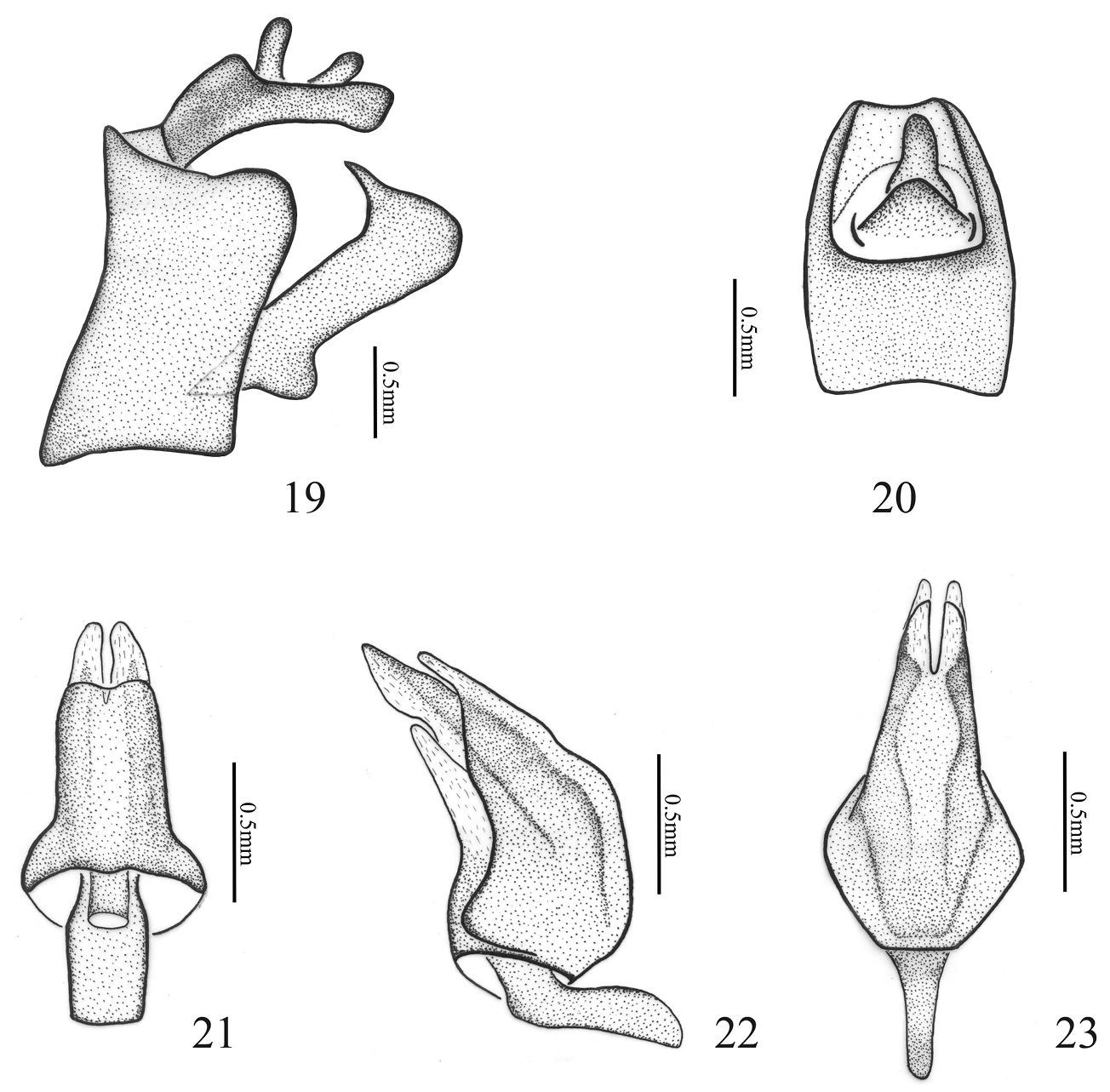






(C) 2010 Cui-Ping Bu. This is an open access article distributed under the terms of the Creative Commons Attribution License, which permits unrestricted use, distribution, and reproduction in any medium, provided the original author and source are credited.
For reference, use of the paginated PDF or printed version of this article is recommended.
Aprivesa unimaculata sp. n. (Hemiptera: Fulgoromorpha: Ricaniidae) is described and illustrated from Coorg, south India. This represents the first record of the genus Aprivesa Melichar from India and the fourth known species of Aprivesa. The new taxon greatly extends the range of the genus Aprivesa, which was previously known as an endemic Australian genus. A checklist of all known species of the Ricaniidae from India and keys to all the known genera of the Ricaniidae from India and all species in the genus are provided.
Ricaniidae, Fulgoroidea, taxonomy, biodiversity, distribution
Ricaniidae is one of the larger families of the Fulgoroidea, comprising more than 450 described species in approximately 46 genera (
The ricaniid fauna of India remains inadequately studied
and there is still much basic taxonomic work to be done on the group. To
date, 28 species in 9 genera from the Ricaniidae are described or recorded from India (
The genus Aprivesa was established by
While sorting and identifying the Ricaniidae from material in the Department of Entomology Insect Collection, North Carolina State University, Raleigh, NC, USA, we found a new species of Aprivesa from south India. The new species represents the first record of Aprivesa in India, and its discovery has broadened our knowledge of the morphology and biogeography of the genus. In this paper, we redescribe the genus Aprivesa and describe and illustrate the new species from south India. A key is given for the separation of the known species in Aprivesa. A checklist of all known species of the Ricaniidae from India and a key to all the known genera of the Ricaniidae from India are also provided.
Materials and methodsThe specimens studied in the course of this work are deposited at the Department of Entomology Insect Collection, North Carolina State University, Raleigh, NC, USA (NCSU).
Specimens used for dissection were cleaned in 10% KOH at room temperature for ca. 12 hours, rinsed in distilled H2O, stained by methylrosanilinium chloride (a clinical solution, comprising methyl violet, ethanol and purified water) to highlight the internal thin and transparent membranous parts, and then transferred to glycerol for examination. Morphological characters were observed with a Zeiss Stemi SV 11 optical stereomicroscope and were illustrated with the aid of a drawing tube attached to the microscope. Measurements were made with the aid of an eyepiece micrometer.
The following abbreviations are used in the text, BL: body length (from apex of cephalic process to tip of fore wing) and FWL: fore wing length.
The morphological terminology followed is that of
Ricaniidae Amyot & Serville, 1843
Apachnas Distant, 1909
Apachnas nobilis Distant, 1909. India (Madras)
Aprivesa Melichar, 1923
Aprivesa unimaculata sp. n. India (Coorg)
Euricania Melichar, 1898
Euricania ocellus (Walker, 1851). India (Assam, Sikkim)
Pochazia Amyot & Serville, 1843
Pochazia antica (Gray, 1832). India (Tamil Nadu)
Pochazia atkinsoni Distant, 1906. India (Sikkim)
Pochaziaconfusa Distant, 1906. India (Assam)
Pochazia guttifera Walker, 1851. India (Assam, Darjeeling, Sikkim)
Pochazia interrupta Walker, 1851. India (Assam, Malabar Coast)
Pochazia sinuata Stål, 1865. Northern India
Pochazia transversa Melichar, 1898. India (Darjeeling)
Ricania Germar, 1818
Ricania apicalis (Walker, 1851). India (Assam, Sikkim)
Ricania bicolorata Distant, 1906. India (Madras)
Ricania coorgensis Distant, 1916. India (Coorg)
Ricania fenestrata (Fabricius, 1775) India (Coorg, Kerala, MadrasTravancore, Trivandrum)
Ricania fumosa (Walker 1851). India (Assam)
Ricania marginalis (Walker 1851). India (Assam, Bombay, Coorg)
Ricania simulans (Walker, 1851). Northern India
Ricania speculum (Walker 1851). India (Assam, Madras, Nilgiri Hills, Sikkim, Trivandrum)
Ricania stupida (Walker, 1857). India (Assam)
Ricania taeniata Stål, 1870. India
Ricania zebra Distant 1906. India (Assam)
Ricanoides Zia, 1935
Ricanoides flabellum (Noualhier, 1896). India (Assam)
Ricanoptera Melichar, 1898
Ricanoptera inculta Melichar, 1898. India (Assam, Nicobar Islands, Great Nicobar)
Ricanoptera polita Melichar, 1898. India (Nicobar Island, little Nicobar)
Ricanula Melichar, 1898
Ricanula pulverosa (Stål, 1865). India (Assam)
Ricanula stigma (Walker, 1851). India (Assam, Nicobar Islands)
Scolypopa Stål, 1859
Scolypopa confinis (Distant, 1906). India (Bombay, Coorg, Madras )
Scolypopa delecta (Melichar, 1898). India (Bombay)
Key to genera of Ricaniidae from India| 1 | Forewing quadrate, with costal and sutural margins subparallel (Figs 9–10, 13) | Aprivesa Melichar |
| – | Forewing more or less triangular (Figs 1–5, 8) | 2 |
| 2 | Forewing with sparse longitudinal veins, costal cell without transverse veinlets (Figs 1–2) | 3 |
| – | Forewing with dense longitudinal veins, costal cell with transverse veinlets (Figs 3–5, 8, 13) | 4 |
| 3 | Forewing with radial vein branched before pterostigma (Fig. 1) | Euricania Melichar |
| – | Forewing with radial vein not branched before pterostigma (Fig. 2) | Apachnas Distant |
| 4 | Forewing large, with apical angle prominent, apical margin longer than claval suture (Fig. 3) | Pochazia Amyot & Serville |
| – | Forewing relatively small, with apical angle rounded, apical margin nearly as long as claval suture | 5 |
| 5 | Forewing with cells on basal portion with numerous anastomosed crossveins | 6 |
| – | Forewing with cells on basal portion without anastomosed crossveins | 8 |
| 6 | Mesonotum with lateral carinae slightly, inwardly and anteriorly curved and bell-like (Fig. 6) | Ricanoides Zia |
| – | Mesonotum with lateral carinae distinctly, inwardly and anteriorly curved and angle-like (Fig. 7) | 7 |
| 7 | Forewing with precostal area with dense transverse veinlets, costal margin distinctly convex near base (see |
Ricania Germar |
| – | Forewing with precostal area with sparse transverse veinlets, costal margin slightly convex near base (Fig. 8) | Ricanula Melichar |
| 8 | Forewing narrower with costal margin/apical margin ratio>1.4 (Fig. 4) | Scolypopa Stål |
| – | Forewing wider with costal margin/apical margin ratio<1.4 (Fig. 5) | Ricanoptera Melichar |
1 Euricania ocellus (Walker, 1851) 2 Apachnas nobilis Distant, 1909 3 Pochazia confusa Distant, 1906 4 Scolypopa delecta (Melichar, 1898) 5 Ricanoptera inculta Melichar, 1898 6 Ricanoides flabellum (Noualhier, 1896) 7 Ricania speculum (Walker, 1851) 8 Ricanula pulverosa (Stål, 1865) Notes: Fig. 1 quoted from
Privesa exuta
General colour ochraceous or fuscous. Vertex and most part of frons usually pale brown or dark brown. Pronotum brown. Mesonotum usually fuscous. Legs pale yellow or brown. Forewing brown to fuscous. Hindwing hyaline, pale brown.
Head (Figs 9–12, see
Pronotum (Figs 9–11)
narrow, with median longitudinal carina, punctuated beside central
carina; disk slightly sloping laterally, hind margin centrally
distinctly arched anteriorly. Mesonotum (Figs 9–11)
large, triangular and convex, with 3 carinae: central carina
straight; lateral carinae inwardly and anteriorly curved, nearly
parallel on anterior margin, each bifurcating outwardly near middle in a
straight longitudinal carina. Forewing (Figs 9–10, 13, see
Female and male genitalia. See description of Aprivesa unimaculata sp. n. below.
Habitus of Aprivesa unimaculatasp. n. 9 ♂, south India, lateral view 10 ♀, south India, dorsal view.
Aprivesa unimaculatasp. n. 11 head (♂), pronotum and mesonotum, dorsal view 12 head (♂), ventral view 13 fore wing (♂) 14 hind wing (♂).
Aprivesa unimaculatasp. n. 15 genitalia (♀), lateral view 16 anal tube (♀), dorsal view 17 genitalia (♀), ventral view 18 gonopophyses VIII (♀), lateral view.
Aprivesa unimaculatasp. n. 19 genitalia (♂), lateral view 20 anal tube (♂), dorsal view 21 aedeagus, dorsal view 22 aedeagus, lateral view 23 aedeagus, ventral view.
As with many ricaniid planthopper species, no biological data are currently available for species of Aprivesa, except that Aprivesa exuta was collected on Melaleuca quinquenervia (
Australia, India.
Aprivesa is distinguished from other genera in Ricaniidae by the shape of frons and wing, the wing venation, and the minutiae of the male genitalia.
Species of Aprivesa are similar to those of Privesa Stål. But Aprivesa can be separated from Privesa
by the lateral margins of the frons with a slight outward bulge below
the antennae and the forewing with two radial veins originating from a
common point on the basal cell (
| 1 | Forewing pale dull ochraceous, with dark mottlings; precostal area at middle 1.6 times as broad as costal cell (see |
Aprivesa pronotalis (Distant) |
| – | Forewing brown or fuscous, with hyaline mottlings; precostal area at middle 2.4 times as broad as costal cell | 2 |
| 2 | Forewing with ratio of length to maximum width 1.8:1, MA relatively long (see |
Aprivesa varipennis Muir |
| – | Forewing with ratio of length to maximum width 2.3:1, MA relatively short | 3 |
| 3 | Forewing with three large hyaline spots, Cu forking about level of junction of claval veins (see |
Aprivesa exuta (Melichar) |
| – | Forewing with one large hyaline spot, Cu forking before junction of claval veins; frons wider at widest part than long in middle line (1.4:1) (Figs 9–13). BL: 6.0 mm (male). India (Coorg) | Aprivesa unimaculata sp. n. |
♂ (n=1), BL: 6.0 mm, FWL: 7.0 mm; ♀ (n=1), BL: 6.0 mm, FWL: 8.0 mm. General colour brown to fuscous. Vertex, frons and clypeus brown. Eye brown. Ocelli yellowish. Rostrum pallid. Pronotum and mesonotum fuscous. Thorax fuscous ventrally, marked with brown. Legs pale brown; tarsi and tips of tibiae fuscous. Abdomen fuscous ventrally, with pale brown transverse strips; pygofer fuscous. Forewing brown, with many pale brown areoles; stigma relatively large, white hyaline. Hindwing pale brown.
Head (including compound eyes) (Figs 9–12) slightly wider than pronotum. Vertex (Fig. 11) wider at anterior margin than long in middle line (5.8:1). Frons (Fig. 12) wider at widest part than long in middle line (1.4:1); disc tricarinate, with sublateral carinae shorter than central carina. Clypeus (Fig. 12) triangular, with central carina. Rostrum long, nearly reaching between hind coxae, with apical segment slightly shorter than basal segment.
Pronotum (Fig. 11) wider at widest part than long in middle line (7.1:1), punctuated beside central carina. Mesonotum (Fig. 11) large, longer than broad, tricarinate on disc, lateral carinae on each side diverging from the middle one, disunited on the anterior border. Wing venation as in Figs 13–14.
Female genitalia (Figs 15–18) symmetrical (
Male genitalia with pygofer (Fig. 19) narrow and high, with dorsal posterior margin smoothly produced posteriorly in lateral view. Anal tube (Figs 19–20) moderately small, distinctly projected caudad, dorsally sulcate in distal half, trapezium in dorsal view, longer than wide at middle (1.3:1). Anal styles (Figs 19–20) relatively short and small. Genital styles (Fig. 19) relatively large and slender, with a long apical process, the base of inner margin curvedly produced, in profile longer than wide at middle (4.3:1). Aedeagus (Figs 21–23) cone-liked, nearly straight, partly sclerotised, symmetrical, having two pairs of caudad directed membranous processes at apex, with the inner pair longer and the outer pair slightly short.
Holotype ♂. Ammatti, S. Coorg, S. India, xi.1982, P S Nathan (NCSU). Paratype: 1♀, S. Coorg, S. India, Ammatti, 3100 ft., v.1951, P S Nathan (NCSU).
This species is named for its forewing with one large hyaline spot.
South India (Coorg).
This species is externally similar to Aprivesa exuta (Melichar, 1898)from Australia, butcan be distinguished from the latter by the characters given in the key.
We thank Dr. Murray J. Fletcher (Orange Agriculture Institute, NSW, Australia) for several discussions on the identification of the new species during the preparation of this manuscript. We are grateful to Mr. Robert L. Blinn and Dr. Lewis Deitz (NCSU), for the loan of specimens used in this study. The work on which this paper is based was supported by the National Natural Science Foundation of China (grant nos. 30770269, 30970400), a grant (No. O529YX5105) from the Key Laboratory of the Zoological Systematics and Evolution of the Chinese Academy of Sciences and the National Science Fund for Fostering Talents in Basic Research (Special subjects in animal taxonomy, NSFC-J0630964/J0109), all awarded to APL.
